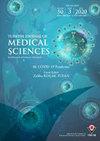羊水分叉蛋白和 MIP-1β 水平高与宫内生长受限有关:一项前瞻性队列研究
IF 1.2
4区 医学
Q2 MEDICINE, GENERAL & INTERNAL
引用次数: 0
摘要
背景/目的:前炎症趋化因子已被证明在着床、螺旋动脉入侵和胎儿-母体免疫反应中起着至关重要的作用。在此背景下,我们研究了宫内生长受限(IUGR)孕妇的母体血清和羊水中的分叉碱(CX3CL1)和趋化因子 CC motif 配体 4(CCL4 或 MIP-1β)的水平。材料和方法:这项前瞻性队列研究于 2022 年 1 月 1 日至 2022 年 7 月 1 日在 Fırat 大学产科诊所进行。组别本文章由计算机程序翻译,如有差异,请以英文原文为准。
High amniotic fluid fractalkine and MIP-1β levels are associated with intrauterine growth restriction: a prospective cohort study
Background/aim: Proinflammatory chemokines have been shown to play crucial roles in implantation, spiral artery invasion, and the fetomaternal immunological response. In this context, we investigated the levels of fractalkine (CX3CL1) and chemokine CC motif ligand 4 (CCL4 or MIP-1β) in maternal serum and amniotic fluids in pregnant women with intrauterine growth restriction (IUGR). Materials and methods: This prospective cohort study was carried out at Fırat University Obstetrics Clinic between January 1, 2022 and July 1, 2022. Group
求助全文
通过发布文献求助,成功后即可免费获取论文全文。
去求助
来源期刊

Turkish Journal of Medical Sciences
医学-医学:内科
CiteScore
4.60
自引率
4.30%
发文量
143
审稿时长
3-8 weeks
期刊介绍:
Turkish Journal of Medical sciences is a peer-reviewed comprehensive resource that provides critical up-to-date information on the broad spectrum of general medical sciences. The Journal intended to publish original medical scientific papers regarding the priority based on the prominence, significance, and timeliness of the findings. However since the audience of the Journal is not limited to any subspeciality in a wide variety of medical disciplines, the papers focusing on the technical details of a given medical subspeciality may not be evaluated for publication.
 求助内容:
求助内容: 应助结果提醒方式:
应助结果提醒方式:


